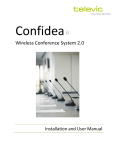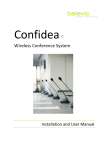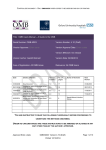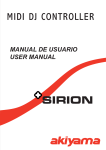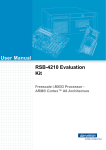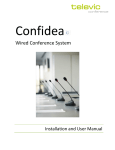Download Installation & User manual
Transcript
confidea Installation & User manual Attention: This manual for Wireless Confidea System 3.0 is valid only for all WCAP+ firmware version ≥ 1.06 WCAP fpga version ≥ 1.06 WDU+ firmware version ≥ 1.06 WCAP+ 71.98.0033 Cocon ≥ 3.02 01 General information 1 Copyright Statement 4 2 Trademarks 5 1 Copyright Statement No part of this publication or documentation accompanying this product may be reproduced in any form or by any means or used to make any derivative such as translation, transformation, or adaptation without the prior written permission of the publisher, except in case of brief quotations embodied in critical articles or reviews. Contents are subject to change without prior notice. Copyright© 2008 by Televic Conference NV. All rights reserved. The authors of this manual have made every effort in the preparation of this book to ensure the accuracy of the information. However, the information in this manual is supplied without warranty, either express or implied. Neither the authors, Televic Conference NV, nor its dealers or distributors will be held liable for any damages caused or alleged to be caused either directly or indirectly by this book. 4 All terms mentioned in this manual that are known to be trademarks or service marks have been appropriately capitalized. Televic NV cannot attest to the accuracy of this information. Use of a term in this book should not be regarded as affecting the validity of any trademark or service mark. 2 Trademarks 2 Trademarks 5 3 Contents 1 Copyright Statement 4 2 Trademarks 5 4 How to connect 8 4.1 Power up 8 4.2 Accessing the web-browser 8 4.3 Login wizard 8 4.4 Introduction 8 First time access 8 4.5 Return to factory settings 5 Web server 12 5.1 Compatibility 12 5.2 Navigating through the webserver 13 5.3 Changing IP address 14 5.4 Initialization 16 5.4.1 5.5 Controlled Access Unit Manager 16 17 5.5.1 Define groups 18 5.5.2 Define delegate names and assign to group 18 5.5.3 Remove delegate 19 5.5.4 Visualize delegate names or numbers in unit manager 19 5.6 Unit monitoring 20 5.7 Activating microphones 21 5.8 Conference options 21 5.8.1 Max active microphones 21 5.8.2 Microphone modes 22 5.8.3 Microphone preset 23 5.9 6 11 AUX Control 24 5.9.1 AUX In/out 24 5.9.2 General Aux settings - Audio routing 24 5.10 Regional settings 26 5.11 Security 26 27 5.13 Check firmware versions of WCAP 28 5.14 Update 28 5.14.1 WCAP update 29 5.14.2 Update delegate units 31 6 Frequency selection 32 6.1 Check already used frequencies by other Confidea G3 systems 32 6.2 Selecting own frequencies 32 6.3 The current used frequency 33 6.4 Frequencies used by other Confidea G3 systems 33 6.5 Other indications 33 6.5.1 Signal quality 33 6.5.2 Sorting frequencies 33 7 Message screen 34 8 Guidelines on optimal WCAP setup and configuration 35 8.1 Positioning the Confidea Wireless Access Point 35 8.2 Optimizing the position the antennas 35 8.3 Max range of WCAP 36 9 Frequency Planning 37 9.1 Use with WiFi base stations nearby 37 9.2 Avoiding interference b.m.o. wifi collection points 37 10 Adding Cocon license to the WCAP 38 10.1 Introduction 38 10.2 Get the MAC address of your central equipment 38 10.3 Upload your license file 39 11 Appendix 40 11.1 Use of camera control feature 40 11.1.1 Overview 40 11.1.2 Connectivity 40 11.1.3 Commands for Confidea Gen III camera protocol 40 2 Trademarks 5.12 Check firmware versions of delegate units 7 4 How to connect 02 4.1 Power up After applying the 24V adapter to the power supply socket and switching the device on, the first LED blinks white. This means the system is booting. Note: If the LED does not switch to green after some minutes or it turns red, please contact your support team. 4.2 Accessing the web-browser To access the web-browser connect the LAN connector directly to your computer or to the LAN network which includes your computer. The default IP address is 192.168.1.110. Please make sure that your PC has an IP address and subnet mask that can access that IP address. 4.3 Login wizard When you enter the web-browser for the first time you will be guided through a small wizard for initial setup of the system. 4.4 Introduction The WCAP has a built-in web server that allows you to set/monitor certain parameters characterizing the wireless conference system. The following is a step-by-step guide to give you a general idea of how to access your WCAP. First time access STEP 1 – PC IP setup Note: The WCAP has a default fixed IP address and subnet mask: IP: 192.168.1.110 Subnet mask: 255.255.255.0 In order to access the built-in web server for the first time, the TCP IP settings from the PC or MAC must be modified. A fixed IP address has to be set. Therefore follow the instructions below. 4 How to connect - Gotothe‘ControlPanel’ - Click on Network and sharing center - Click on Change adapter settings - Right-click on Local Area Connection - Double on Properties - Click on Internet Protocol (TCP/IP) - Click Properties Static IP address WINDOWS 7 - Input your IP Address and subnet mask the IP addresses on the network must be within the same range. - The default IP address from the WCAP is 192.168.1.110 so the computer should have an IP Address that is within the same subnet, like 192.168.1.11 and 192.168.1.20. The subnet mask must be the same for all equipment on the network: 255.255.255.0) - Click OK Assigning a fixed IP Address in WINDOWS 7 - Enter the IP Settings op the PC - In this example the PC has normally “10.0.40.85” as IP address. - Click on Advanced and add a new IP address that is in the range of the access point, for example 192.168.0.26 and subnet mask 255.255.0.0 - Click to add 9 - Click OK STEP 2 - Accessing WCAP Open Internet Explorer or any other browser (with the computer connected to the WCAP) Enter 192.168.1.110 or wcap3.local into the Address Bar, press Enter A wizard will guide you through the initial system setup: 10 - Choose your language - Then you can choose to be notified when updates are available. This requires that the WCAP has a connection to the internet. - In the next item you have to fill in a hostname. This is a name which can be associated with the device for easy recognition in the system. Also when you have multiple WCAPs running simultaneously, you will be able to identify which frequencies are used by which hosts 4 How to connect - After you’ve completed the wizard you need to login. The default login and password are Login: admin Password: admin 4.5 Return to factory settings If the ip address is not known then a return to factory settings (default ip address) is possible by pressing the reset button next to the middle antenna , during 10 sec , and release the button . Following screens will appear while pushing reset button and wait until the circle is completed whenreleasingresetbutton… 11 5 Web server 5.1 Compatibility The webserver is compatible with various types of mobile and desktop devices 12 5 Web server 5.2 Navigating through the webserver Click on either of the available icons and navigate through the menu b.m.o. the scrollbar After entering a submenu , use the arrow to go back to the main menu => home button => unit monitoring menu => settings menu => initialization menu => delegate unit manager => security settings 13 => frequency settings =>c onference options => Aux control => regional settings => network settings => login settings => update screen =>message screen => system information 5.3 Changing IP address First we will change the IP address of the system. To do this you have to go to the settings. This can be done by clicking the settings icon. 14 5 Web server Then scroll all the way down until you see the following icon network settings. which indicates the In this menu you define: - Hostname - Address mode (Static – DHCP) Static: in this mode the IP address and subnet mask is fixed and must be provided in the appropriate fields. DHCP: DHCP stands for Dynamic Host Configuration Protocol and is a protocol used by the WCAP to obtain the parameters necessary for operation in an Internet Protocol network automatically. This protocol reduces system administration workload, allowing the WCAP to be added to the network with little or no manual configuration. There must be a DHCP server on the network that dynamically assigns IP addresses when using the DHCP setting. - IP address Here you can enter the desired fixed IP address. Only applicable in fixed IP address mode. - Subnet mask - Gateway setting 15 We advise to change the IP address. This will prevent conflicts when multiple access points with the same IP address are in the network. 5.4 Initialization In stand-alone mode, the WCAP supports two kinds of access: open access and controlled access. - Open access: This is the default mode. Any unit can connect to the WCAP without initialization procedure - Controlled access: a unit can only connect after going through an initialization procedure. 5.4.1 Controlled Access In this mode, a manual initialization is required. The manual initialization procedure requires the use of the 3 buttons on the web server displayedabove:“Openinit”,“Closeinit”and“Clearinit”. Take the following steps to initialize all units: 16 1) Switch on all wireless units As long as no WCAP was discovered , the mic leds wil flash green slowly 3) When the units have discovered the WCAP. This is indicated by both mic leds blinking red slowly 4) Selectthe“ClearInit”,toclearanypreviouslycreatedinitializationlist. 5) Start thenewinitializationbyselectingthe“Open Init”button. Afteryoustartedthenewinitialization,theredMicrophoneStatusLED’sonallwireless units will start to blink red . 5 Web server 2) Mic leds blinking red at a rate of 2Hz is an indication that the units are trying to connect to the Wcap Mic leds blinking red at a rate of 1Hz is an indication that the units are waiting for the initialization 6) To add a unit to the initialization list, press the microphone button of the unit to add. 7) The LEDs will turn green indicating that the unit has been added to the initialization list. 8) Repeat step 5 for each unit that needs to be added. 9) Whenfinished,stopandsavetheinitializationbypressingthe“Closeinit”button, Only the units that have been initialized will now be able to join the conference. The init list is stored in the WCAP and stays in memory even after switching the WCAP off. Next time the WCAP and delegate units are switched on, only these units will be allowed to connect to the WCAP. 5.5 Unit Manager The unit manager allows to: - Define delegate names - Define groups 17 As you can see there are two main parts, the left column is the list of delegates; the right column is the list of groups. Each delegate shows an array of information, from left to right: - Autonomy - Version - Serial number - Packet loss (if any) In rare cases it may appear that the delegates background is red, this means the delegate is running a golden version. Although this works, we strongly advice to reapply the update so that these units can be used to their full potential. 5.5.1 Define groups A group is defined by two parameters: - Group name - Group color Youcanmakeanewgroupbyclickingonthe“Addnewgroup”button. Add a group name and select (optionally) a group color. Press enter to save the group. Editing the group can be done by right-clicking (or swiping) on the group entry. A small popup appears to edit or remove the group. 5.5.2 Define delegate names and assign to group Right-click (or swipe) on the delegate you want to group. A small popup appears, click on edit. 18 5 Web server Change the name; assign delegate to group. Enter to save settings. Note: clearing the initlist will also clear the delegate names, but not the group 5.5.3 Remove delegate Right – click (or swipe) on the delegate Clicking or remove will delete the delegate unit from the initlist. This feature is only useful when manual init is used. 5.5.4 Visualize delegate names or numbers in unit manager => shows first 3 characters of the delegates name in the delegate icon , firmware version , battery status and serialnumber => shows first character of the delegates name in the delegate icon, firmware version , battery status and serialnumber 19 => shows delegate unit nr in the delegate icon, firmware version , battery status and serialnumber 5.6 Unit monitoring To monitor the delegate ujnits activity and/or control the mcirophones select the menu A group overview now appears. Each group info can be expanded or collapsed by means of the or icon in the main button => List by delegate names => List by groupnames => List by first character of the delgates name => List by delegate unit number => show first 3 characters of the delegates name in the delegate icon , delegate name and group , when microphone is on => show first character of the delegates name in the delegate , delegate name and group , when microphone is on 20 => shows delegate unit nr in the delegate icon ,delegate name and group , when microphone is on Microphones can be activated by clicking on the delegate name in the monitoring screen Microphones control button can be activated activated by right click on the delegates name 5 Web server 5.7 Activating microphones Activated microphones are indicated by following icon Microphones in request ar are indicated by following icon 5.7.1 Disconnected units If delegate units are disconnected or lost RF link with the WCAP due to removed or depleted battery for instance, to long distance from WCAP ..they are shown as greyed out in the monitoring screen A unit that lost connection to the wcap will be shown greyed out after +/_ 30 sec 5.8 Conference options 5.8.1 Max active microphones Max 6 microphones can be on at the same time . Chairman units always have priority and if max is reached , microphone of the delegate units will be deactivated to allow chairman units to switch on their microphone . In this case the microphone of the delegate unit which was switched on the longest , will be deactivated automatically . 21 5.8.2 Microphone modes 5.8.2.1 Operator only operator can activate microphone via webserver or Cocon software 5.8.2.2 Direct speak: Enables the participant to turn on or off his microphone at any time. The only limitation here is the maximum number of microphones that may be active simultaneously. => When this option is on and the the maximum active microphones setting is reached, activation of an additional microphone will automatically switch off the microphone that was active for the longest time. Again, the chairmen units can always be activated. 5.8.2.3 Request: Enables the participant to send a request to speak to the chairman or conference operator by pressing the microphone button (or to cancel his request by pressing the microphone button again). Once the floor is requested, the first one in the queue has blinking green mic leds , the other ones have fixed green mic leds, this means that the delegate unit is in request mode. The chairman or conference operator grants the participant the permission to speak by using the NEXT button or by activating the microphone via Cocon software , if used. => this option allows the participant to cancel his own request by pressing the microphone button again 5.8.2.4 Group discussion: Any microphone can be switched until the maximum active microphones setting is reached. Other participants can switch their microphone in request mode. The first applicant who requested the floor gets the floor when one of the currently active microphones is turned off . When a chairman pushes the NEXT button , the microphone which was active the longest time , will be switched off and the first one in the request queue will be switched on The first one in the queue has blinking green mic leds , the other ones have fixed green mic leds 5.8.2.5 VOX Is similar to direct speak + interrupt possible , but microphones are switched on by voice detection Vox Treshold Determines the sound level needed to activate the mic by VOX 22 A threshold setting whichs to high might result in a microphone not being switched on or switched on to late. A threshold setting which is to low might results in a microphone being switched on by ambient sound Also the microphone preset setting will influence the choice of the Treshold level . 5 Web server VOX treshold is to be chosen in such way that a microphone is switched on directly after the person begins to speak. Vox Time out The microphone will be switched off when the Vox threshold level is not reached during the amount of seconds set in the Vox time out A Vox time out setting which is to low might result in interrupted audio when there is a pause or low passage in the audio. Vox Pencil drop suppression Avoids accidental microphone activation because of short sounds. This setting may cause a short mic activation delay General remark on use of VOX : A high microphone preset combined with strong audio input may result in the perception that the VOX activation is to slow due to the limiter release time. 5.8.2.6 Last microphone remains on When this option is set , the audio of the last delegate microphone which was switched off, still captures the sound , this way acting as an ambient microphone. In this situation the mic ringled and mic leds are not on anymore .When any othermicrophoneisswitchedonagain,the“ambient” microphone is then switched off. The chairman unit is not affected by this feature A“lastmicon”statusisindicatedasmicactivebutwithoutthemicicon Last mic on Mic on 5.8.3 Microphone preset Determines the sensitivity of the microphone . This chosen setting will depend on - how close or far the person is sitting from the microphone. Volume of external loudspeakers if present ; a FAR setting + high volume of external loudpeakers or external loudspeakers positioned close to the microphones may cause acoustic feedback External compressor limiter device : in this case CLOSE must be used as setting to allow maximum adjustability on the external compressor-limiter device (see also AUX control settings) 23 5.9 AUX Control The Confidea G3 WCAP has one auxiliary input and one auxiliary output 5.9.1 AUX In/out status : switches off or on the Aux input level : volume adjustment Professional level : 2 inputlevel ranges are possible : OFF (= Consumer level) : nominal level -10DBV , max input level +10dBV ON (= Professional level) : nominal level +4dBu , max input level +24dBu The professional level setting should be set equal for both Aux In and Aux Out 5.9.2 General Aux settings - Audio routing 5.9.2.1 None No additional audiorouting is done 24 ∑ Level: 0..32 Status RMS detector ∑ Std. 32 Level: 0..32 Std. ON Status Signal present Std. 32 OL 5 Web server ≤6 SP Std. ON 5.9.2.2 Distance conferencing Distance conferencing (= N-1) option adds external signal , via aux in , to the local floor signal and sends the local floor signal , via aux out , to the remote party. ≤6 ∑ Level: 0..32 Status OL RMS detector ∑ Std. ON Std. 32 Level: 0..32 Status SP Signal present Std. ON Std. 32 5.9.2.3 External processing Activatingthe“externalprocessing”optionallowstoaddexternalsignalprocessingequipment or a mixing board. 25 ≤6 ∑ Level: 0..32 Status RMS detector ∑ Std. 32 OL Std. ON External processing unit Level: 0..32 Status Signal present Std. 32 SP Std. ON 5.10 Regional settings Language : In the regional settings the webserver language setting can be changed Region : the selected country or region will determine which frequencies can be used according to local regulations 5.11 Security The security uses a AES 128 bit encryption. The system has a built-in default factory encryption key. To increase the security even further, or to make sure only specific delegate units can connect to the wcap , another random encryption key can be generated and uploaded. This key will be send to all delegates connected to the system. Once other encryption option is selected only those units having the encryption will be able to log onto the system. If a unit needs to be added to the system, default encryption needs to be selected first. 26 5 Web server 5.12 Check firmware versions of delegate units If the firmware version does not correspond with the uploaded file , for some units , the update needs to be redone to ensure all units have the same firmware version . This can be checked via the unit monitoring list => shows # microphones activated and provides shortcuts to unit monitoring and frequency setting menu 27 5.13 Check firmware versions of WCAP 5.14 Update The update page can be found by going to the settings submenu and clicking on the update button (displayed as two arrows in a circular formation). There is the choice to choose to check automatically for available updates via www.updates.televic-conference.com or to do a manual file selection When you get to the update page you can have one of these two situations: - No update available: either you have the latest software and an update is not necessary or no update file has been uploaded. - There is an update available: this could either be because you’re connected to the internetandthere’snewversionavailableorthatyouhavemanuallyuploadedafile. Note thatthroughtheinternetupdatesystemyou’llonlyreceivethelatestupdates.Older updates will still need to be installed manually. To upload a file, click on the upload button in the right upper corner After you’ve selected a file, this will be uploaded automatically, however not installed automatically 28 The file is a compressed folder which will be automatically extracted by the system The file for the WCAP updatehasfollowingnameformat“AP.x.yz.tar“ or “AP.x.yz.tuf“ (both are ok) Following screen appears and after a few seconds the system is ready to start the installation of the updates and info is shown regarding the latest changes 5 Web server Thefileforthedelegateunitsupdatehasfollowingnameformat“WDU.x.yz.tar“ or“WDU.x.yz.tuf”(both are ok) Tostarttheupdate,press“installupdates”.(Note that when you received the update over the internet, the file will be downloaded first, so do not disconnect). One the update has started; you’llgetanoverlayprotectingyoufrommakingany changes to the system. 5.14.1 WCAP update Once the WCAP update is started following screens will appear 29 During the update the WCAP led1 is green on and led2 is blinking white. When the update is finished following screen will appear An update may take a while; do not under any circumstances turn off the device. During the system update, the device will reboot a few times, during which you cannot use the device. If the update fails, the system will boot in golden mode from which you can retry the update. 30 5.14.2 Update delegate units 5 Web server When updating delegate units,makesurethey’rebatteryischarged>=50%andthatyou have the least amount of interference as interference will drastically increase the time to update. After a delegate update, only the devices will be reboot. Once the WCAP update is started following screens will appear The reset takes about 2 min During the update the mic leds on the delegate units will light up red – left , green - right , after 10 sec, red – right , green - left , etc…… The update takes about 20 min Remark : If a unit is accidentally switched off during the update (e;g; due to empty battery) , this will temporarily stop the update , but after a few minutes the update for the other units will continue 31 6 Frequency selection 6.1 Check already used frequencies by other Confidea G3 systems By clicking and dragging the indicated button , from right to left and back , any other Confidea G3 system which are connected to the same LAN network will be shown by theuir hostname and currently active frequency. 6.2 Selecting own frequencies => enter frequency selection screen => add this frequency as frequency that may be used Frequency selection can be done by means of adding the mark in the checkbox in the below screen If more then one frequency is marked , the WCAP select automatically a frequency amongst those marked 32 The current used frequency is marked with the antenna icon 6.4 Frequencies used by other Confidea G3 systems Frequencies used by other Confidea G3 systems which are connected to same LAN network (see chapter 7.1) are mentioned in the below screen ; the identification of the other Confidea G3 sustem(s) is doen by their hostnames 6 Frequency selection 6.3 The current used frequency 6.5 Other indications 6.5.1 Signal quality => shows the quality of the signal , based on interference detected on that frequency => low signal quality due to interference or low level => high signal quality , least or no interference => do not use this frequency , because signal strength to low or signal to disturbed 6.5.2 Sorting frequencies => mark/unmark all frequencies toggle button => sort frequencies according to signalquality 33 => sort frequencies by numerical order => sort frequencies by numerical order per RF band => show all frequencies in this RF band => collapse all frequencies in this RF band 7 Message screen The message screen can be used as monitoring or analysis tool . Every event , change of settings , warning….isshownhere (last message at the bottom). => enable messages concerning delegate units connecting , microphone activations => enable message concerning change of settings => enable warnings 34 8 Guidelines on optimal WCAP setup and configuration 8.1 Positioning the Confidea Wireless Access Point Attention: Do not place the WCAP behind obstacles like walls , cabinets, panels, projection screen, glassscreensetc…,astheysignificantlyreduceRFsignal strength and quality Below you can find how to select a correct positioning of the WCAP. Note : When the antennas of the WCAP are positioned very close to a wall or ceiling , this may result in absorption of the RF signal , which can decrease RF signal quality. 8 Guidelines on optimal WCAP setup and configuration => other messages 8.2 Optimizing the position the antennas Note :It is important not to point the antennas directly to the units Choosing the correct angle of the antennas in relation to the position of the delegate units is beneficial to a good overall RF link quality between WCAP and delegate units 35 8.3 Max range of WCAP AsingleWCAPhasarangeof30min“openfield”. However the max range can be significantly less depending on the positioning of the WCAP itself and direction of the antennas in relation to the position of the delegate units. Note : Certain buildingmaterials like concrete , or metal may absorb part of the RF signalradiation, resulting in a reduction of the max distance between the access point and units 36 9.1 Use with WiFi base stations nearby If more than one WCAP or Wifi accesspoints are in the same room or within 30m. range , it is strongly advised that not more than one of them uses automatic frequency selection , to avoid that the frequencyscanning is disturbed by the other accesspoint(s) . If multiple accesspoints are used within eachother’sreach,manualfrequencyselection based on frequency planning is strongly recommended to avoid that wifi access points and Confidea WCAP would use the same frequencies When the Confidea wireless system is set to manually selected the wireless carrier frequency, then you must make sure the Confidea wireless carrier does not overlap the already occupied WiFi wireless carrier channels. 9 Frequency Planning 9 Frequency Planning When using manual frequency selection in 5gHz band , ideally the frequency selection is done in such waythatbetween2usedfrequencies,thereisa40Mhz“distance”toavoidinterferencebyRFsidebands. 9.2 Avoiding interference b.m.o. wifi collection points ThetransmissionmodebetweenWDU’sandWCAPisspeciallydesignedto be used in very challenging environments where a high density of wifi signals is present due to wifi access points as well as so called smart devices , which may cause RF interferences Wifi devices such as smartphones , I-Pads…..maysendregularprobingsignalsovertheentire wifi band to search for a wifi connection. This probing can cause temporary interference and will continue until a wifi connection was established. When a large number of wifi devices is present in the room , these probing signals may cause WDU connection loss due to saturation of the used frequency . Therefore it is strongly recommended that a wifi collection point is set up, so wifi devices can lock on to them and this way reduce further the risk of interference. Note : The wifi access points must have sufficient capacity to ensure wifi connection for all present wifi devices . If there is not a sufficient wifi connection capacity for the present mobile wifi devices , unstable functionality of the Confidea wireless system due to interference can not be excluded ! 37 10 Adding Cocon license to the WCAP 10.1 Introduction WiththereleaseofConfideaGen3we’vechangedtheCoConlicensefilelocationfromthePCwhere the Room Server is installed, to the device to which CoCon will be connecting. This means that now you do not need to send us the MAC address of your PC but the MAC address of your Confidea Gen 3 Access Point. This way the license is independent of the computer onto which the CoCon Room Server is running, the license will allow only 1 concurrent connection and the software will adapt automatically to the license modules which are active in the license file. To obtain the MAC address of the Confidea Gen 3 WCAP please follow the procedure underneath. 10.2 Get the MAC address of your central equipment The default IP address Confidea Gen 3 WCAP is 192.168.1.100. Please use a recent web browser to browsetotheaddressesindicated.Ifit’sthefirsttimeyousetupyourdeviceasmallwizardwillappearto set your language and etc. Youcanloginusingusername“admin”andpassword“admin”.(Yes,we’vebeenverycreativethis time…).Thengotothesettingspage: Then click on the license file icon: 38 [email protected] 10.3 Upload your license file Then you will receive an email containing your requested license file. This is an xml file which you can open with notepad or something similar to verify if the correct modules have been activated. The name of the file contains the MAC address of your device. To upload your file onto your central equipment, click on the upload button below the mac-address: 10 Adding Cocon license to the WCAP Please copy this MAC address and send it along with your P-number (can be found on the CoCon box) to the following email address: Then a popup will appear. Please select the received license file. It will load onto the device and its content will appear. Now you can connect CoCon with the central equipment. 39 11 Appendix 11.1 Use of camera control feature 11.1.1 Overview The Confidea Gen III Conference System supports a camera control. The commands, which the camera control should understand, will be described shortly. Confidea Gen III WCAP sends out data via UDP to the camera system The camera control function can be enabled via the Confidea Gen III webserver 11.1.2 Connectivity The Confidea Gen III WCAP sends the camera commands via UDP to a destination ip-address , which can be defined in the Confidea Gen III webserver . The default UDP communication port is 8000. When selecting a port nr manually via the Confidea Gen III webserver, a portnr > 3000 should be chosen. 11.1.3 Commands for Confidea Gen III camera protocol Available settings via Confidea Gen III webserver => => Enabled : 0 = off , 1=on Ip address = destination ip address (udp) of camera system Port = destination port (udp) The data which is send by the Confidea Gen III WCAP after a microphone button event , is in JSON format, {“UID”: micnr,“status”: x} 40 Micnr : micronumber , one or more digits e.g. of data send when microphone 7 is in request : {“UID”: 7,“status”: 2} 11 Appendix Status : 0 = off, 1 = on, 2 = request , 3 = prior 41











































